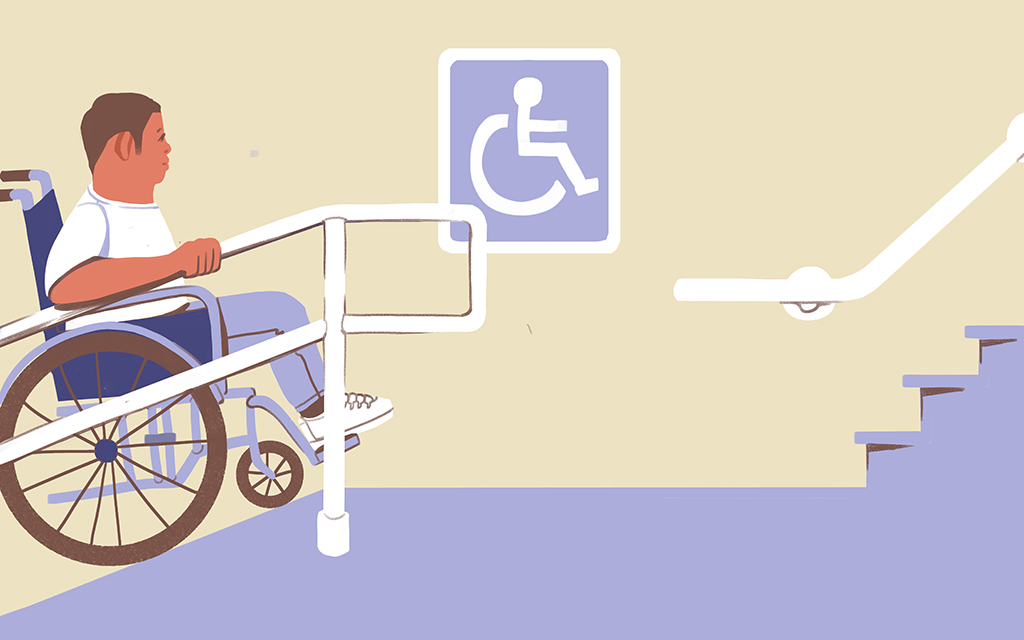Building a more inclusive Singapore for people with disabilities
5 Nov 2018
By Jeanne Mah
 GRAPHIC: KELLEY LIM
GRAPHIC: KELLEY LIM
For most of us, getting around in Singapore is not an issue. Pavements are well-maintained here, overhead bridges let us cross roads easily and a well-connected public transport network makes for fast journeys.
However, daily commutes are not always easy for people who are wheelchair-bound or who have disabilities.
In February, The Straits Times published an article highlighting the ubiquity of wheelchair roadblocks in the Central Business District. For instance, while Raffles City MRT station has nine exits, only one is accessible to wheelchair users, since they require a lift to reach the ground floor.
Furthermore, older shopping malls such as the Golden Wall Centre and Golden Mile Complex at Jalan Besar do not have any automated doors. Even in newer shopping centres such as Suntec City and Vivocity, there are no proper rest stations for wheelchair users despite large floor spaces.
In NTU, there are many steep hills and narrow pathways, which make it almost impossible for students on wheelchairs to reach their destinations. Travelling from a Hall of Residence to the nearest bus stop can also be challenging, especially when the area is crowded and the pathway is too narrow to pass through.
Singapore’s lack of wheelchair-friendly facilities sends the wrong message that the needs of disabled people are not important. It must tailor its infrastructure to be more handicap-friendly, if it aims to be an inclusive society for all Singaporeans.
There are currently 100,000 wheelchair users in Singapore, which include the elderly and people with disabilities, TODAY reported in 2014.
Due to an aging population, this number is likely to increase, according to the Ministry of Social and Family Development and the Department of Statistics, which are working together to estimate the number of wheelchair users Singapore will have by 2020.
People with disabilities often feel marginalised in Singapore. In a 2015 survey of 1,000 disabled people conducted by the National Council of Social Services, 62 per cent said that they did not feel included, accepted, or given opportunities to contribute or reach their potential by society.
Government support
To address the needs of people with disabilities, the Singapore government has taken steps to improve their lives by creating more wheelchair-friendly facilities.
For example, at popular attractions like Gardens By The Bay, pathways are wide enough for wheelchairs users to navigate them easily.
Meanwhile, the National Museum of Singapore has designated parking spots for handicapped-labelled vehicles, as well as handicapped toilets and lifts on all floors.
Under the Green Man Plus scheme, senior citizens and disabled pedestrians have an extra crossing time of three to 12 seconds when they tap their electronic cards against card readers on traffic light poles.
When the government demonstrates willingness to make everyday life easier for people with disabilities, more organisations are encouraged to follow suit. There will also be greater awareness of the importance of building an inclusive society for the disabled.
The government can therefore continue to implement more wheelchair-friendly initiatives, not just at popular places or busy roads, but everywhere.
Moving forward
Besides building a more handicap-friendly infrastructure system, Singapore will benefit from having a society that is more kind and compassionate towards people with disabilities.
What does such a society look like? It is made up of simple actions that make a big difference for a disabled person. It means being more patient when a wheelchair user is moving past a crowd, not showing displeasure if he takes a long time to alight from a bus, and stepping forward to help him if he has problems crossing the road.
For a start, schools can educate students on the struggles faced by people with disabilities, such as limited mobility, and the importance of empathising with them.
These efforts will go a long way towards building an inclusive, handicap-friendly Singapore that makes people with disabilities feel at home.


